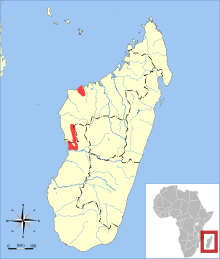- Pygmy mouse lemur
-
Pygmy mouse lemur[1] 
Conservation status Scientific classification Kingdom: Animalia Phylum: Chordata Class: Mammalia Order: Primates Family: Cheirogaleidae Genus: Microcebus Species: M. myoxinus Binomial name Microcebus myoxinus
Peters, 1852
Pygmy mouse lemur range Pygmy mouse lemur (Microcebus myoxinus), also known as Peters' mouse lemur or dormouse lemur, is a primate weighing only 43–55 g (1.5–1.9 oz); it is the second smallest of the mouse lemurs.[3] Its dorsal side is a rufous-brown colour, and creamy-white ventrally. It lives in dry deciduous forests.
The pygmy mouse lemur measures around 12–13 cm (4.7–5.1 in) (head-body length).[3] Its small size and nocturnal nature made it difficult to locate for over a century, and was rediscovered in the Kirindy forest in western Madagascar in 1993. They are believed to inhabit other parts of the island, but so far have only been discovered in a localized area.
The lemur rests during the day, and it has a tendency to sleep in the open, which increases the risk of predation; although this danger is somewhat mitigated by sleeping alone. It can also use the abandoned nests of the Coquerel's giant mouse lemur (Mirza coquereli).
References
- ^ Groves, C. (2005). Wilson, D. E., & Reeder, D. M, eds. ed. Mammal Species of the World (3rd ed.). Baltimore: Johns Hopkins University Press. pp. 113. OCLC 62265494. ISBN 0-801-88221-4. http://www.bucknell.edu/msw3/browse.asp?id=12100020.
- ^ Andrainarivo, C., Andriaholinirina, V. N., Feistner, A., Felix, T., Ganzhorn, J., Garbutt, N., Golden, C., Konstant, B., Louis Jr., E., Meyers, D., Mittermeier, R. A., Perieras, A., Princee, F., Rabarivola, J. C., Rakotosamimanana, B., Rasamimanana, H., Ratsimbazafy, J., Raveloarinoro, G., Razafimanantsoa, A., Rumpler, Y., Schwitzer, C., Thalmann, U., Wilmé, L. & Wright, P. (2008). Microcebus myoxinus. In: IUCN 2008. IUCN Red List of Threatened Species. Downloaded on 1 January 2009.
- ^ a b Mittermeier, R.A.; et al. (2006). Lemurs of Madagascar (2nd Edition ed.). Conservation International. p. 104–107. ISBN 1-881173-88-7.
Extant species of family Cheirogaleidae Cheirogaleus
(dwarf lemurs)Microcebus
(mouse lemurs)Gray mouse lemur (M. murinus) · Reddish-gray mouse lemur (M. griseorufus) · Golden-brown mouse lemur (M. ravelobensis) · Northern Rufous mouse lemur (M. tavaratra) · Sambirano mouse lemur (M. sambiranensis) · Simmons' mouse lemur (M. simmonsi) · Pygmy mouse lemur (M. myoxinus) · Brown mouse lemur (M. rufus) · Madame Berthe's mouse lemur (M. berthae) · Goodman's mouse lemur (M. lehilahytsara) · Jolly's mouse lemur (M. jollyae) · Mittermeier's mouse lemur (M. mittermeieri) · Claire's mouse lemur (M. mamiratra) · Bongolava mouse lemur (M. bongolavensis) · Danfoss' mouse lemur (M. danfossi) · MacArthur's mouse lemur (M. macarthurii) · Arnhold's mouse lemur (M. arnholdi) · Margot Marsh's mouse lemur (M. margotmarshae)Mirza
(Giant mouse lemurs)Allocebus Phaner
(Fork-crowned lemurs)Category
This lemur-related article is a stub. You can help Wikipedia by expanding it.

